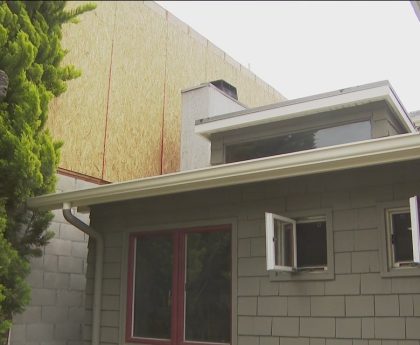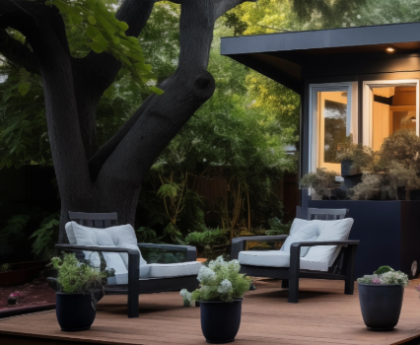The Iowa City City Council passed the first consideration to remove several restrictions for Accessory Dwelling Units after a lengthy discussion Monday night.
A packed Emma J. Harvat Hall gathered for the council’s decision on two affordable housing-based amendments to the long-time city code. Many immigrant speakers shared stories of residential struggles in Iowa City and emphasized a need for additional housing.
The council approved a first consideration of changes to the zoning code that would remove code-based restrictions on ADUs. Iowa City associate planner Kirk Lehmann delivered a staff report during the Nov. 6 meeting, which included an estimate that housing demand in Iowa City will greatly outpace supply by the year 2030.
The report predicted a need for 4,600 additional residences by the decade’s end. Lehmann’s report predicts having access to only 2,800 residences based on current growth, falling short by about 1,800 units.
Lehmann emphasized the alignment of ADUs with the city’s strategic plan, one of the key pillars to reduce housing barriers.
More:What to know about voting on Election Day in Johnson County
What are Accessory Dwelling Units? What would these amendments change?
Accessory Dwelling Units are “small, self-contained dwelling units located on the same lot as a primary home.” These can include above-garage units, detached units, attached units and interior upper and lower-level units.
Iowa City code restricts ADUs to certain residential zones, requiring at least one parking spot. The code also requires the property owner to live on the same site as the ADU.
The code limits the size of an ADU as well — either 650 square feet or 30% of the floor area of the main building — and does not allow the main building’s square footage to increase by more than 10%. The proposed amendment would increase the allowable square footage to 1,000 square feet or up to 50% of the floor area of the main building.
ADU restrictions vary wildly across the county, Lehmann said. In Des Moines, for example, the city has a similar 50% square footage restriction but requires both owner and occupant to have an available parking space.
Code changes, if passed and adopted by the council, could also have a large impact on the supply of units. Currently, 13,000 units in Iowa City are eligible for ADUs. About 1,400 new units would be allowed to develop accessory dwelling units.
The report also suggests removing the owner-occupancy requirement could generate an additional 3,100 units. The amendment states that ADUs cannot be operated on rental property. This would have the largest impact within the University Impact Area, where about 75% of the additional units would be created. It was a hot topic for councilors throughout a long discussion period.
More:Iowa City OKs zoning code changes, applies for federal affordable housing grant
Future requirements for owner-occupancy discussed
City staff and the Planning and Zoning Commission nearly agreed on recommendations to the council — except on the owner-occupancy requirement. The commission voted that the owner-occupancy requirement remain in place by a 4-3 tally.
Councilors, led by a proposal from Laura Bergus, suggested they agree to pass the amendments — with the owner-occupancy requirement intact — and return to amend the passed changes and remove that requirement after consulting with the Planning and Zoning Commission.
Any “substantive” alterations to the code proposed by the council would require the council to confer with the Planning and Zoning Commission and delay the passage of the changes entirely.
Bergus and Megan Alter wanted to pass the amendments as soon as possible while eliminating the owner-occupancy requirement outside of the University Impact Area. Inside the zone, the requirements would remain, except for non-profit landlords who provide income-restricted affordable housing.
“This would continue the process so that we can get this through,” Alter said.
“And then we can expand it,” Shawn Harmsen added, with nods of approval across the council.
The council approved the changes with a note to meet with the Planning and Zoning Commission to tweak the amendments further.
“I think that’s a really good compromise, based on what we’re hearing from the public,” John Thomas said. “We’re hearing that, outside the University Impact Zone, we’re not hearing any objection to that concept. Within the University Impact Zone, we’ve had serious concerns about [owner-occupancy requirements]. And, I think, as I’ve been trying to emphasize, within the University Impact Zone, it’s difficult to create deep affordable housing and this would be one way to do that.”
Other affordable housing-based code changes finalized and adopted
The council also passed and adopted changes to the zoning code, with councilors voting 5-2 to accept 30-plus pages of redline changes aimed at increasing housing choice, supply and affordability.
Councilors John Thomas and Pauline Taylor voted “no” for the third consecutive time, with Thomas asking to amend the code for a University Impact Zone density bonus for duplexes.
A majority “no” vote would have restarted a process that began in August. However, Thomas’ minor proposed code change “would likely cause the [suggested] provision to go unused without altering the proposed changes,” city staff wrote in a memo to the council earlier this year.
Ryan Hansen covers local government and crime for the Press-Citizen. He can be reached at[email protected] or on X, formerly known as Twitter, @ryanhansen01.





